ECON1210 Intorductory Microeconomics Final Examination June 4, 2020
Hello, dear friend, you can consult us at any time if you have any questions, add WeChat: daixieit
ECON1210 Intorductory Microeconomics
Final Examination
Date: June 4, 2020, 14:30-16:30 (+ 15 minutes of grace period)
1. My university ID number is [ Answer01 ].
Please refer to the background information below to answer question 2 to 8.
The student union of a local university has complained to the Utopia’s Ministry of Bubble Tea that the price of bubble tea (dollars per cup) is too high and requested the Ministry to do something about it. The Minister promises to consider two specific policies proposed by the students: (1) price ceiling on bubble tea, and (2) a price ceiling on boba. The market supply and demand curves of bubble tea are given by the following equations.
Demand: Q = 20 − P million cups per year
Supply: Q = 4.2P − 4.5 million cups per year
2. From the information, we can conclude that the unregulated market equilibrium price is [ Answer02A ] dollars per cup and equilibrium quantity is [ Answer02B ] million cups per year.
3. At the unregulated market equilibrium, the consumer surplus is [ Answer03A ] million dollars per year and the producer surplus is [ Answer03B ] million dollars per year.
4. The Minister considers a price ceiling on bubble tea proposed by the students: 3.23 dollars per cup. At this proposed price ceiling, there will be a shortage of [ Answer04 ] million cups of tea per year.
5. At this proposed price ceiling on bubble tea, consumer surplus is expected to be [ Answer05A ] million dollars per year, and producer surplus to be [ Answer05B ] million dollars per year.
(Assume that all transacted quantity are somehow allocated to consumers with the highest willingness to pay. No bribery and no need to wait in line.)
6. Students also wanted the Minister to consider a price ceiling on boba: 3.58 dollar(s) per unit of boba. Boba is a major input for making bubble tea. Bubble tea is produced using one unit of tea for each unit of boba. The hope is that such policy helps lower the production cost of making bubble tea and yet would not result in any shortage in the final product market (i.e., bubble tea).
The supply curve of boba is given by the equation
Qb = 3.42Pb million units of boba
After the policy is in place, we expect shops sell bubble tea for [ Answer06A ] dollars per cup, and the market quantity will be [ Answer06B ] million cups of bubble tea per year.
7. Given the price ceiling on boba, we expect that the consumer surplus of bubble tea consumption will be [ Answer07 ] million dollars per year.
8. Thus, if the objective is to maximize consumer surplus in the consumption of bubble tea, the Ministry should
A) not impose any of the regulatory measures proposed by the students.
B) impose a price ceiling of 3.23 dollar(s) per cups of bubble tea.
C) impose a price ceiling of 3.58 dollar(s) per unit of boba.
[ Answer08 ]
9. John is thinking about watching a football game with his friend. John is willing to pay $189 for watching the game. A ticket of the game costs $74 and he will have to cancel his part-time job that pays $295. Normally, he would be unwilling to do the part-time job for less than $Y . (John views the unpleasantness of the part-time job as an offset against its salary.) John will decide to watch the game if Y is at least [ Answer09 ].
Please refer to the background information below to answer question 10 to 12.
John and Mary are the only people in Islandia, a small island nation. They both produce shelter and
clothing. Let C denote the quantity of clothing, and S denote the quantity of shelter. The following equations summarize their production possibility curves (PPCs).
John: C = 6 − 2S
Mary: C = 126 − 7S
10. Suppose Islandia is a closed economy. If John and Mary would like to jointly consume 20 units of shelter, they would be able to jointly consume a maximum of [ Answer10 ] of clothing.
11. In this closed economy, any admissible term of trade between John and Mary has to be larger than [ Answer11A ] units of clothing per unit of shelter and smaller than [ Answer11B ] units of clothing per unit of shelter.
12. Suppose Islandia is now opened up to trade with the rest of the world, and can trade at a world term of trade of 9.5 units of clothing per unit of shelter. If John and Mary would like to jointly consume 20 units of shelter, they would be able to jointly consume a maximum of [ Answer12 ] of clothing.
13. Eric, Flora, Glen and Howard can produce bells and whistles. The table below shows their productivity (units per hour).
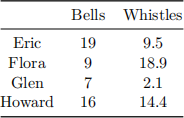
If this small economy wants to allocate two persons to completely specialize in the production of bells, who should be allocated to the production of bells?
A) Eric and Flora
B) Eric and Glen
C) Eric and Howard
D) Flora and Glen
E) Flora and Howard
F) Glen and Howard
[ Answer13 ]
14. France and Italy trade tanks and jets. France can produce one jet with 25000 man hours, and one tank with 14000 man hours. Italy can produce one jet with 30000 man hours, and one tank with
5000 man hours. You are on the Italian team bargaining over the terms of trade. You tell the defense minister that the best terms of trade you can reasonably ask for are [ Answer14A ] tanks per jet and the worst you can accept are [ Answer14B ] tanks per jet.
Please refer to the background information below to answer question 15 to 16.
Consider the following individual production possibilities curves of Stephen and Paul (not drawn to scale),
where a = 100, b = 550, c = 550, d = 100.
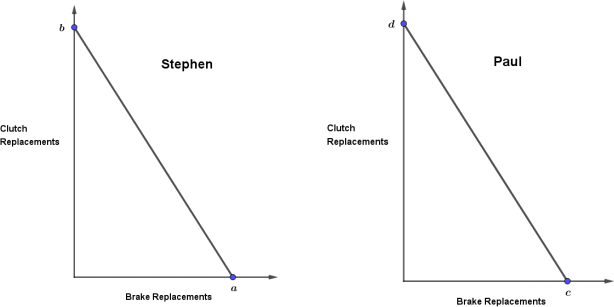
Stephen and Paul both work at Trustworthy Garage. Cars being served in the garage all require one standard maintenance service, i.e., one clutch replacement and one brake replacement.
15. If Stephen and Paul work separately, they can perform in total [ Answer15 ] standard maintenance services (can be non-integer).
16. If Stephen and Paul work together, they can perform in total [ Answer16 ] PERCENT MORE standard maintenance services than working separately.
17. Lochheed is the monopoly supplier of lake-monster sightings in the Scottish Highlands. It faces a demand curve given by the equation
Q = 23950 - 28P lake visits
From this information, we can identify that the marginal revenue curve is in the form of
MR = A - BQ
where A is equal to [ Answer17A ], and B is equal to [ Answer17B ]
Please refer to the background information below to answer question 18 to 24.
Utopia doctors immunize children against measles, a highly contagious and potentially deadly virus. The
demand and supply curves for the immunization are given by the following equations.
Demand: Q = 200 − P thousand immunizations per year
Supply: Q = 1.5P − 85 thousand immunizations per year
but the social marginal benefit (SMB ) is given by the following equation
Q = 200 - 0.9 × SMB thousand immunizations per year
and the private marginal cost and social marginal cost are identical.
18. If the market is left unregulated, the market equilibrium level of immunization is [ Answer18 ] thousand immunizations per year.
19. The total economic surplus to the society from the market equilibrium level of immunization is [ Answer19 ] thousand dollars per year.
20. The socially efficient level of immunization is [ Answer20 ] thousand immunizations per year.
21. The total economic surplus to the society at the socially efficient level of immunization is [ Answer21 ] thousand dollars per year.
22. Suppose the government decides to address the inefficiently low rate of immunization by paying doctors for every immunization. That is, the cost of immunization to the general public is zero. The total economic surplus to the society with such publicly-paid immunization is [ Answer22 ] thousand dollars per year.
23. If, instead, the government applies a per unit subsidy on immunization to achieve the socially efficient level, it should implement a per unit subsidy of [ Answer23 ] dollar(s) per immmunization.
24. This per unit subsidy will cost the government a total of [ Answer24 ] thousand dollars of subsidy expenditure per year.
Please refer to the background information below to answer question 25 to 28.
There are 15 doctors living at the mid-level of a hill. The hospital is located at the foot of the hill. Every morning, each doctor can either drive or use free tram service down the hill to go to work. As there is only a small road down the hill, traffic congestion may occur if many doctors choose to drive. If n doctors choose to drive, it will take each doctor 2n + 4 minutes to drive down the hill (n can only take integer values). On the other hand, it always takes 12 minutes to get down by tram. Assume that all doctors have the same opportunity cost of time ($20 per minute); and, other than driving time, all driving related cost are negligible.
25. If the doctors make their decisions individually, we would expect [ Answer25 ] doctors will drive in equilibrium.
26. From the society’s perspective, we should have [ Answer26 ] doctors driving.
27. If the government charges a $60 toll for the road, and the doctors make their decisions individually, we would expect [ Answer27 ] doctors will drive in equilibrium.
28. Suppose any policy (such as the toll collection) to regulate the road usage is feasible only with an implementation cost of $C per day. At its best, the government can in fact set a toll to achieve the socially optimal number of doctors driving. From the society’s perspective, such policy should be implemented only if C is less than [ Answer28 ].
Please refer to the background information below to answer question 29 to 30.
The demand for aluminum (tons per day) by Ali Motor and Baba Motor are given by the following equations
Ali: QA = 1000 − 0.3P
Baba: QB = 900 − 1.2P
29. We know that the market demand (consisting of Ali and Baba) should look like the graph below.
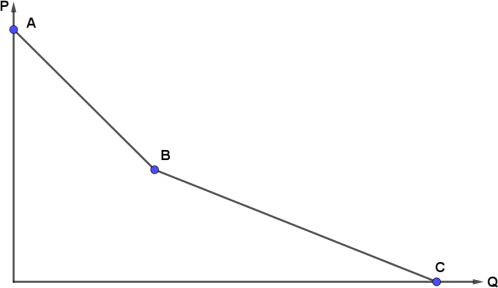
We can identify the three points as:

30. Given this market demand for aluminum, at the price of 50 dollars per ton, the consumer surplus in this market is [ Answer30 ] dollars per day.
Please refer to the background information below to answer question 31 to 34.
The market of fortune cookies is perfectly competitive. John’s Fortune Cookies is one of the many perfectly competitive firms. Assume that the only variable input required for the production is workers. The following table shows the relationship between the number of workers hired and the total output (packs of fortune cookies produced).
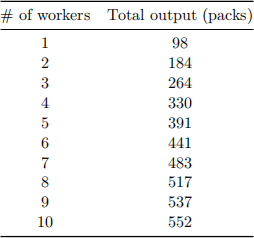
John pays a fixed cost of $380 per day, and to each employee a wage of $54 per day. The price of fortune cookies is $1.14 per pack.
31. Given such information, we can calculate the marginal product due to the 3-rd worker is [ Answer31 ].
32. Given such information, in the short run, John should hire [ Answer32A ] workers, and thus produce [ Answer32B ] packs of fortune cookies.
33. Consequently, in the short run, John will make a profit of [ Answer33 ] dollars.
34. Suppose the fixed cost has become $570 per day. In the short run, John should hire [ Answer34A ] workers and thus produce [ Answer34B ] packs of fortune cookies.
35. The corner gas station sells cigarettes, facing a linear downward sloping demand curve. To maximize revenue, the manager set the price equal to 36 dollars and sold a quantity of 40 packs per day on average. But to discourage smoking, the government just set a per-pack tax of 2 dollars, to be paid by the buyer. Now, to maximize revenue, the manager will reduce quantity by [ Answer35 ] packs per day on average.
(Assume cigarettes are perfectly divisible.)
Please refer to the background information below to answer question 36 to 39.
There are many identical firms (having the same production costs and producing the same product) in a
competitive market. Their product is assumed to be perfectly divisible. When one firm produces q units,
its marginal cost is
MC (q) = q
and the corresponding total variable cost is
TVC (q) = 0.5q2
The demand curve in the market is
Q = 9000 - 90P
Moreover, assume that the industry is constant cost. The market is currently in a long-run equilibrium, and the equilibrium price is $45 per unit.
36. Using the information, we conclude that there are [ Answer36 ] firms in the market.
37. Using this information, we conclude that the fixed cost of an individual firm is [ Answer37 ] dollars.
38. Using this information, we conclude that the short-run supply curve of this industry is of the form
Q = A + B × P
where A is equal to [ Answer38A ], and B is equal to [ Answer38B ]
39. Suppose now the market demand has become
Q = 15300 - 153P
Using the information, we can calculate that in the long run, an individual firm will produce [ Answer39 ] units.
40. Your boss Jeff wants you to maximize revenue from sales of postcards in your souvenir shop. Previously, you sell 150 cards on a typical day when you set a price of 1 dollar each. After knowing the objective from your boss, you experimented with setting a price of 1.25 dollars each, and found that you can sell 52 cards on a typical day. After gathering such information, and assuming that Jeff is facing a download sloping linear demand, you suggest to Jeff that the revenue-maximizing price is [ Answer40 ] dollars per card.
Please refer to the background information below to answer question 41 to 43.
Suppose the Financial Secretary of Utopia wants our help designing a per-hour wage subsidy (paid to workers) to raise employment and workers’ pay. Given a wage P measured in Utopia dollars, the supply and demand for labor (per year) are given by the following equations.
Demand: Q = 17000 − 35P million hours
Supply: Q = 65P − 17000 million hours
41. Without government intervention, the equilibrium wage is P = [ Answer41A ] dollars per hour and the equilibrium quantity is Q = [ Answer41B ] million hours.
42. Suppose the aim is to increase employment by 58 million hours. We should suggest a wage subsidy of [ Answer42A ] dollars per hour and recognize that such policy will result in a deadweight loss of [ Answer42B ] million dollars.
43. Suppose the Financial Secretary would like to use subsidy to increase employment as much as possible but he does not want the deadweight loss to exceed 150 million dollars per year. Then, we should suggest a maximum subsidy of [ Answer43 ] dollars per hour.
Please refer to the background information below to answer question 44 to 51.
Godzilla Electric (GE) is the monopoly supplier of electricity to households on Utopia Island. It faces a demand curve, a marginal cost curve, and a fixed cost given by following equations
Demand: Q = 101 − 0.02P thousand megawatt-hours per day
Marginal Cost: MC = 80 dollars
Fixed Cost: F C = 240 thousand dollars
44. The profit-maximizing GE would produce [ Answer44A ] thousand megawatt-hours of electricity per day, and set a price of [ Answer44B ] dollars per megawatt-hour.
45. The price elasticity of demand at the profit-maximizing quantity is [ Answer45 ]
46. The markup at the profit-maximizing quantity is [ Answer46 ] percent.
47. The profit at the profit-maximizing quantity is [ Answer47 ] thousand dollars per day.
48. The socially efficient quantity is [ Answer48 ] thousand megawatt-hours.
49. Compared to the socially efficient quantity, monopoly pricing leads to a deadweight loss of [ Answer49 ] thousand dollars per day.
50. The Utopia Government is considering a Scheme of Control by setting the maximum price per megawatt-hour of electricity to be the average of profit-maximizing price and the marginal cost. Under this scheme of control, GE will choose to produce [ Answer50 ] thousand megawatt-hours.
51. Suppose any Scheme of Control (such as the one in the last question) is feasible only with an implementation cost of $C per day. At its best, the government is capable of setting up a specific Scheme of Control (need not be the same as the one in the last question) to achieve the socially efficient quantity. From the society’s perspective, the government should implement such Scheme of Control only if C is less than or equal to [ Answer51 ] thousand dollars per day.
52. Suppose in a market, the price elasticity of supply is constant at 4.5 and the price elasticity of demand is constant at -2.7. Following a 3% change in supply (parallel rightward or leftward shift), we expect to have [ Answer52A ]% change in the price and [ Answer52B ]% change in the quantity traded.
53. After a new per-unit subsidy of $4.7 is introduced on widgets, we observed that the price of widgets paid by the consumers decreased by $2.9. What can we conclude?
A) Demand for widget is relatively more price elastic than the supply
B) Demand for widget is relatively less price elastic than the supply
C) The price elasticity of demand for widget is the same as the price elasticity of supply.
D) We cannot draw any conclusion on demand and supply elasticities of widgets.
[ Answer53 ]
Please refer to the background information below to answer question 54 to 59.
![]() In Utopia, Uber sells miles of travel to senior citizens (s) and younger citizens (y) whose demand curves for Uber rides are given by the following equations
In Utopia, Uber sells miles of travel to senior citizens (s) and younger citizens (y) whose demand curves for Uber rides are given by the following equations
Demand (s): Qs = 1000 − 65Ps thousand miles
Demand (y): Qy = (1000/8) − (65/8)Py thousand miles
and the marginal cost is a constant $1 per mile for either kind of rider.
54. Suppose Uber decides to set a single price for both groups, and maximize profits accordingly. Then, Uber will sell [ Answer54 ] thousands of miles.
55. When a single price is set, Uber will charge a price of $[ Answer55 ] per mile.
56. With a regulatory cost of $C, the government can implement a policy to completely eliminate the inefficiency due to the single-price monopoly. For the government to find it beneficial to implement the policy, C must be less than [ Answer56 ].
57. Suppose Uber decides to set one price for each group, and maximize profits accordingly. Then, Uber will sell [ Answer57A ] thousands of miles to senior citizens at a price of $[ Answer57B ] per mile.
58. And, it will sell [ Answer58A ] thousands of miles to younger citizens at a price of $[ Answer58B ] per mile.
59. The total consumer surplus under Uber’s single-price scheme is [ Answer59 ] thousands dollars LESS THAN the total consumer surplus under Uber’s dual-price scheme.
Please refer to the background information below to answer question 60 to 62.
Julian and Kevin are neighbours. They are considering the joint installation of a large fountain near their houses so that each can enjoy its beauty and also improve the value of their property. Their marginal benefits from the fountain are summarized by the following equations
Julian: MBJ = 50 − 3D
Kevin: MBK = 42 − 1.5D
where D measures the diameter of the fountain in metres. In addition, MBs are constrained to be non- negative. For instance, when D = 1000, the equations described above would imply MBJ = -2950 and MBK = -1458, but in this case, the “non-negative” constraint on MB means that we should instead interpret MBJ = 0 and MBJ = 0 for this D = 1000.
60. The total marginal benefit should look like the graph below.
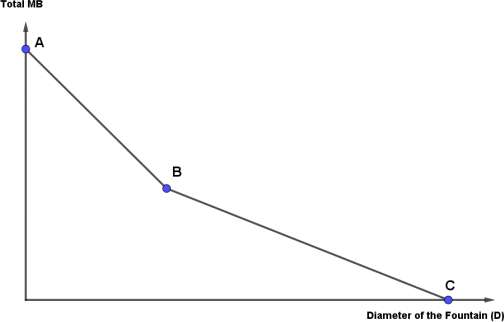
We can identify the three points as:

61. Suppose the marginal cost of producing the fountain of diameter D is constant and equal to $24 per metre. Given this marginal cost, the social optimal diameter of the fountain should be [ Answer61 ] metres.
62. Suppose the marginal cost of producing the fountain of diameter D is equal to $(24 + D) per metre. Given this marginal cost, the social optimal diameter of the fountain should be [ Answer62 ] metres.
63. The supply curve is linear and upward sloping and the demand curve is linear and downward sloping. How many of the following statements is/are TRUE?
(1) If buyer is more price elastic than sellers, buyers will share less burden of the tax.
(2) If the government levied a tax of 1 dollar for each gallon of gas, the price of gas increases by less than 1 dollar.
(3) When the price elasticities of demand and supply are both inelastic, the decrease in overall benefifit received by consumers and producers is less than the gain to the government in tax revenue.
(4) For the same amount of tax per unit imposed, deadweight loss is smaller when the demand/ supply is more price elastic.
A) 0
B) 1
C) 2
D) 3
E) 4
[ Answer63 ]
64. A good is called ________ if the good is rival in consumption and non-excludable.
A) private goods
B) common resources
C) club goods
D) public goods
[ Answer64 ]
65. After finishing homework assignments, David’s father gave him 60 minutes to allocate between the two activities: playing video games and reading newspapers. David’s marginal benefits from the two activities are described by the two functions:
Video games: MBG = 795 - 5G
Newspapers: MBN = 670 - 4N
where G and N are the time (in minutes) spent on the two activities respectively. Assume that time is perfectly divisible. We would predict that David will spend [ Answer65 ] minutes on video games and the rest on newspapers.
66. Li can produce with or without a filter on his smokestack. Production without a filter results in greater smoke damage to Fung, say to Fung’s health.

Suppose the property right is well assigned to either parties. When the negotiation cost for the two parties to reach an agreement is zero, we would expect Li to produce [ Answer66 ] filter.
A) with
B) without
Please refer to the background information below to answer question 67 to 68.
Two electricity generation firms, X and Y, can have the choice to reduce their emissions of pollution with a cost. The marginal costs of reducing the pollution of the two firms are different but are both increasing in the quantity of pollution reduction (tons), as described by the following two equations:
![]()
![]()
![]() Firm X: MCX = 666 + 2.2RX dollars per day
Firm X: MCX = 666 + 2.2RX dollars per day
Firm Y: MCY = 625 + 2.4RY dollars per day
where RX and RY are the quantity of pollution reductions (in tons) of the two firms respectively. When polllution is not regulated, the two profit-maximizing firms will spend no effort in pollution reduction, and hence generate the following quantity of pollution.
Firm X: 256 tons
Firm Y: 276 tons
Now, the government would like to reduce the overall pollution by half by issuing tradable pollution permits
of 266 tons, with 128 tons allocated to Firm X and 138 tons allocated to Firm Y. Under the pollution
permit scheme, a firm will be allowed to generate q tons of pollution only if the firm has pollution permits of q tons. Suppose these permits are perfectly divisible and the negotiation cost to reach an agreement between the two firms is zero.
67. We would expect Firm X to produce [ Answer67 ] tons of pollution.
68. We would expect Firm Y to produce [ Answer68 ] tons of pollution.
69. A publisher is deciding how best to sell the textbooks of Microeconomics and Macroeconomics. The publisher can either sell Microeconomics and Macroeconomics separately as two textbooks, or bundle them as one textbook that contains both subjects. Suppose the cost of supplying the textbooks is zero. There are two students in the market and their willingness to pay for the content are summarized in the table below.

The publisher can make a profit of [ Answer69 ] dollars.
70. Consider the market of fish X. Two events happened recently.
Event 1: The price of the wine that is usually consumed with X increases.
Event 2: Global warning has reduced the population of fifish X in the sea.
We can predict [ Answer70A ] in equilibrium price
A) an increase
B) a decrease
C) an uncertain change
and [ Answer70B ] in equilibrium quantity.
![]()
![]()
![]()
![]()
![]()
![]() A) an increase
A) an increase
B) a decrease
C) an uncertain change
70. In view of the recent pandemic, an NGO has recruited eight volunteers to distribute free face masks to residents (one pack per resident) in the three districts: “Eastern”, “Western” and “Central”. The major decision is the allocation of the volunteers among the three districts, so as to maximize the amount of face masks distributed. The following table shows the amount of masks (packs) that will be distributed in a district as a function of the number of volunteers deployed in the corresponding district. For instance, when 2 volunteers are sent to Central District, a total of 412 packs of masks will be distributed there.
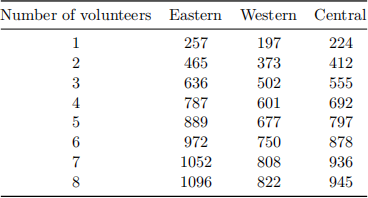
To maximize the amount of masks distriuted, the NGO should allocate [ Answer71A ] volunteers to Eastern District, [ Answer71B ] to Western District, and [ Answer71C ] to Central District.
2023-07-04